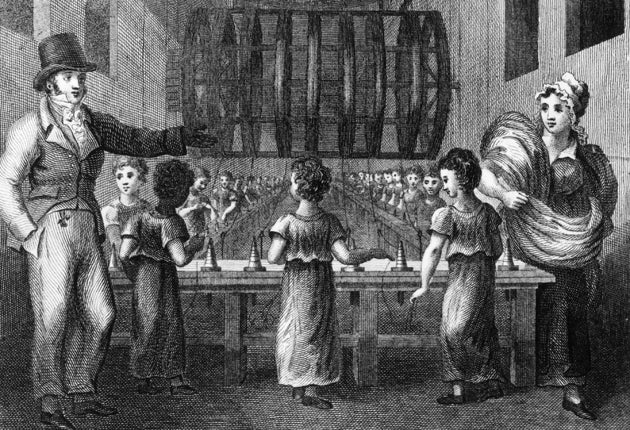Revealed: Industrial Revolution was powered by child slaves
Huge factory expansion would not have been possible without exploitation of the young

Your support helps us to tell the story
From reproductive rights to climate change to Big Tech, The Independent is on the ground when the story is developing. Whether it's investigating the financials of Elon Musk's pro-Trump PAC or producing our latest documentary, 'The A Word', which shines a light on the American women fighting for reproductive rights, we know how important it is to parse out the facts from the messaging.
At such a critical moment in US history, we need reporters on the ground. Your donation allows us to keep sending journalists to speak to both sides of the story.
The Independent is trusted by Americans across the entire political spectrum. And unlike many other quality news outlets, we choose not to lock Americans out of our reporting and analysis with paywalls. We believe quality journalism should be available to everyone, paid for by those who can afford it.
Your support makes all the difference.Child labour was the crucial ingredient which allowed Britain's Industrial Revolution to succeed, new research by a leading economic historian has concluded.
After carrying out one of the most detailed statistical analyses of the period, Oxford's Professor Jane Humphries found that child labour was much more common and economically important than previously realised. Her estimates suggest that, by the early 19th century, England had more than a million child workers (including around 350,000 seven- to 10-year-olds) – accounting for 15 per cent of the total labour force. The work is likely to transform the academic world's understanding of that crucial period of British history which was the launch-pad of the nation's economic and imperial power.
Early factory owners – located in the countryside in order to exploit power from fast-flowing rivers – found that local labour was scarce and that those agricultural workers who were available were unsuitable for industrial production. They therefore opted instead to create a new work force composed of children, tailor-made for their factories.
"Factory owners were looking for cheap, malleable and fast-learning work forces – and found them ready-made among the children of the urban workhouses," said Professor Humphries. Her statistical research shows, for the first time, the precise extent to which the exploitation of children massively increased as newly emerging factories began their operations in the late 18th and early 19th centuries.
Her work has revealed that during most of the 18th century only around 35 per cent of ten year old working-class boys were in the labour force while the figure for 1791-1820 (when large scale industrialisation started) was 55 per cent, rising to 60 per cent for the period of 1821-1850.
The number of eight-year-old working-class boys at work also rose substantially in that period – with around a third of them being part of the work force between 1791 and 1850 compared to less than 20 per cent before 1791.
The use of working-class children to provide much of the labour force for the Industrial Revolution was, however, merely an expansion and extension of an already long-established practice of working-class children employed by farmers or artisans.
Professor Humphries's research – just published by Cambridge University Press – reveals that the average age at which working-class children started work fell from eleven and a half (prior to 1791) to 10 for the period 1791-1850.
The new research shows the extent to which Britain's Industrial Revolution – the first in the world – was initially dependent, as far as the factories were concerned, on what were, in effect, child slaves. They weren't paid – simply fed and given dormitory accommodation. In the 1790s, there were, at any one time, tens of thousands of such unpaid child workers.
Her statistical analysis of vast quantities of data, extracted from 600 autobiographies, is also revealing how the Industrial Revolution helped change life and culture in other ways too.
Industrialisation removed rigid social control over young people's lives and allowed them therefore to get married much younger (typically in their early twenties rather than their mid to late twenties). This led to much larger families which in turn led to rapid population growth – and a sharp reduction in the percentage of women in the work force. Whereas in agricultural society, women had been integrated into the work force, industrialisation and the increase in family size drove them into the home while their husbands and sons went out to work in mines, railways, docks and factories.
Together with the Industrial Revolution and the increase in family size, a range of other factors – wars, empire-building and labour mobility – strained fathers' links to their growing families, and single-parent households increased dramatically.
By the early 19th century, up to 18 per cent of families were being abandoned by fathers. Many other men died in accidents, epidemics and wars – and the new research suggests that around a third of working-class children grew up in single-parent families.
"This process further increased pressure on mothers to send their young children out to work," said Professor Humphries. "The new research is revealing for the first time the extent to which the English Industrial Revolution – and indirectly the imperial expansion it helped generate – depended on child labour. The newly collated evidence transforms our understanding of the causes and consequences of the Industrial Revolution – especially the nature of the labour force and the relationship between the family and the economy," she said.
Childhood and Child Labour in the British Industrial Revolution by Jane Humphries, published by Cambridge University Press
Join our commenting forum
Join thought-provoking conversations, follow other Independent readers and see their replies
Comments